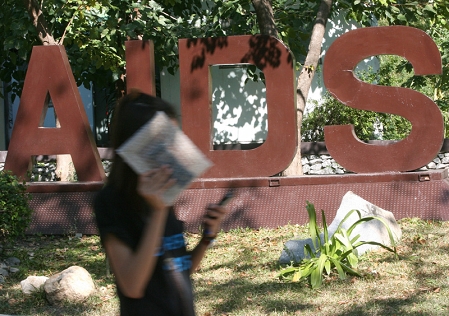Erstellt am: 27. 11. 2010 - 14:53 Uhr
HIV and Human Rights
Question: which of the following is the best way to treat and prevent the spread of a transmissible disease?
a) make sure that everyone who is infected gets the right medicine;
b) make sure that everyone who is at risk of infection takes steps to protect themselves;
c) make sure that the human rights of all those affected are respected.

EPA - NARONG SANGNAK
The answer, of course, is all of the above, but it’s the last point which is at the centre of the global campaign against HIV and AIDS. It’s what’s referred to in UN/NGO-speak as a “rights-based approach”. Because of the stigma attached to HIV and AIDS, people living with the virus are often the victims of discrimination. In some countries they are directly and indirectly targeted by the law. When prejudice and fear take hold, human rights suffer. At the same time, stigmatisation, discrimination, and criminalisation make it harder to treat and prevent HIV infection. It’s particularly relevant in the case of “vulnerable populations” – gay men, sex workers, people who use drugs and prisoners. “We need to get the confidence and trust of these groups in testing programmes and in treatment programmes because if their rights are not protected, then they go underground. They don’t present to services, they don’t become involved in delivering prevention messages to their peers and the HIV response falls apart” explains John Godwin, a human rights lawyer who works with a number of United Nations agencies.

EPA - NARONG SANGNAK
Some examples of the rights involved include
- the right not to be discriminated against –people should be protected against discrimination if they seek help or are HIV+;
- the right to privacy – people should be protected against mandatory testing and their HIV status should be kept confidential;
- the right to liberty and freedom of movement – people should be protected against imprisonment, segregation, or isolation in a special hospital ward;
- the right to education and information – people should have access to all HIV prevention education and information and sexual and reproductive health information and education.
The rights-based approach is an issue which affects civil society as well governments. One thing that is essential when it comes to bringing about change is information. In order to pressure governments to change their laws, it’s necessary to identify those that offend. Breaking down stigma can only be successful if it’s clear what kinds of policies work. Two programmes are in place which aim to gather just the kind of hard evidence which is needed. The UNAIDS secretariat is working together with the International Planned Parenthood Foundation, the International Community of Women living with HIV/AIDS and the Global Network of people living with HIV/AIDS to develop an index on human rights, stigma and discrimination. The Stigma Index is run by and for people living with HIV and comprises an in-depth survey of people’s experiences. The information gathered can be used to campaign for political and legal reforms.
GNP+ also initiated the Global Criminalisation Scan which is used to map laws which are used to prosecute people for transmitting HIV. A recent prominent example in Europe was the conviction of No Angels singer Nadja Benaissa for grievous bodily harm and attempted bodily harm for having unprotected sex without disclosing her HIV status. In a case in the United States a man was jailed for 35 years for spitting at a policeman – he had HIV and the law regarded his saliva as a “deadly weapon”. Such use of the law may be intended to prevent the spread of HIV, but GNP+ says there is no evidence to link the rate of HIV infections in a country with the country’s willingness to use criminal laws to regulate transmission. Indeed, the opposite might be the case, as such verdicts fuel stigma, which makes it more likely that people will feel uncomfortable about disclosing their status and seeking support. The criminalisation scan seeks to understand how the use of such laws affects the human rights of people living with HIV, but it can also be used to ensure that those who might be targeted are aware of the legal pitfalls, so they can avoid unwittingly falling into them.


